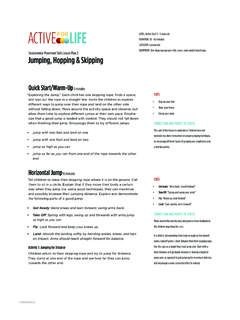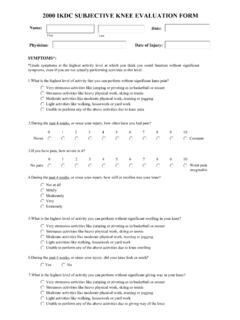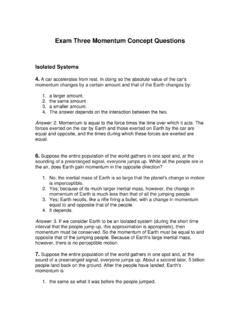Transcription of Ages and Stages Characteristics and Implications for ...
1 Ages and Stages Middle childhood is an exciting time for children. It s more than just a time for losing baby teeth. Often it is the time when first childhood memories are made and when many other changes are happening to and around the child. By understanding Clover Kids members current developmental stage, and by offering challenging opportunities to help them transition into the next stage, you can help make 4-H a rewarding and fulfilling experience for them. Characteristics and Implications for Children Ages 5 6 PHYSICAL DEVELOPMENT Characteristics Implications Physical growth is lower than during infancy and early childhood. Plan activities using large motor skills and introduce fine motor skills, one at a time.
2 Muscular coordination and control is uneven and incomplete. Large muscles are easier to control than small muscles. Plan lots of physical activity with each meeting. Able to handle tools and materials more skillfully than during preschool years. Introduce new physical activities that require coordination such as roller skating, bike riding, rope jumping and simple outdoor games. Can throw different-sized balls better than they can catch them. Most cannot bat well. Provide projects that don t require perfection and that can be successfully completed by beginners. Most can learn to snap fingers, whistle and wink. Provide patient guidance and encouragement for fine motor activities. May repeat an activity over and over to master it.
3 MENTAL DEVELOPMENT Characteristics Implications Unable to handle abstract ideas. Give instructions verbally and visually. Don t expect them to read. Can distinguish their own left and right, but not yours. Avoid a lot of paper and pencil activities that require writing. Define things by their use, , pencil is for writing. Plan a series of small activities broken up by long times of physical exercise rather than one longer session. Just learning letters and words. By six, most can read words or combinations of words. Plan active learning around concrete objects. Short attention span, sometimes as little as five to ten minutes. Provide lots of materials and mediums for learning ( , paper, paint, brushes glue, building blocks, games, puzzles).
4 EMOTIONAL DEVELOPMENT Characteristics Implications Sensitive to criticism, doesn t accept failure well. Always encourage effort. Strong desire for affection and adult attention. Provide lots of opportunities for adult interaction with children. Cooperative and helpful Provide opportunities for children to help in adult-like ways, such as setting up for an activity. Get upset with changes in plans and routine. Give clear description of what your activity or schedule will be and maintain it. Say what they think and feel, , you stink, you re ugly, etc. SOCIAL DEVELOPMENT Characteristics Implications Learning to play cooperatively. Prefer to work in small groups of two or three. Still like to focus on his or her own work or play.
5 Organize projects and activities that involve two or three children. If there is a larger group, break activities into sections so that only two or three are involved at one time. May begin to pair up to have a best friend; however, the best friend may change frequently. Help children develop friendships through learning to share, taking turns, following rules and being trustworthy (not tattling). Mother (or parent) is still social focus as prime caregiver; however, may fall in love with kindergarten teacher. Organize activities with high adult/child ratios. Likes being part of and around family. Develop projects and activities involving or focusing on the family. Can engage in group discussions. Avoid competition or activities that select a single winner or best person.
6 May have need to first, to win, or to be the best and may be bossy. Use imaginary play that involved real-life situations (playing store, playing house). Can be unkind to others, but extremely sensitive to criticism of self. Characteristics and Implications for Children Ages 7 8 PHYSICAL DEVELOPMENT Characteristics Implications Period of slow, steady growth. Will have difficulty with some fine motor projects such as gluing, cutting, hammering nails, bouncing balls, etc. Learn best if physically active. Can throw a ball more easily than catching it. Still awkward at some activities using small muscles, but have improved large muscle activities like riding a bike, skating or jumping rope. Provide opportunities to practice skills, but use projects that can be completed successfully by beginners.
7 May repeat an activity over and over before mastering it. MENTAL DEVELOPMENT Characteristics Implications May spend more time alone doing projects, watching TV or day-dreaming. Give instructions verbally and visually. Most children will be able to read and comprehend simple instructions. Beginning to understand the perspective of others. Can introduce some written assignments and activities; however, most children will still prefer to be active. Beginning to tell time. Activities requiring sorting, organizing or classifying will be enjoyed. Enormous curiosity and delight in discovery. Encourage children to develop or make collections. Are able to collect, sort, organize and classify. Encourage projects that can be done over and over in different ways.
8 Can recognize some similarities and differences. Use lots of activities requiring the children to participate in a hands-on way. Can do some abstract thinking, but learn best through active, concrete methods. Guide the children in reflecting on their learning experience. EMOTIONAL DEVELOPMENT Characteristics Implications Increased awareness of themselves, more sensitive to others. Enjoy making gifts for family. Enjoy being part of the family. Involve them in doing things for others. Worry about failure or being criticized. Be sensitive when teaching a new concept or skill that a child may resist. Break it down in small steps and provide reinforcement at each step. Will try themselves out on others to see how they are accepted.
9 Provide lots of adult encouragement and praise. May claim tasks are too hard rather than admit being scared. SOCIAL DEVELOPMENT Characteristics Implications May be moody, but less likely to direct negative feelings toward others. Introduce the art of social graces. Teaching table manners and other social niceties will be more accepted. Have high expectations of parents and adults and are critical when parents mess up . Activities will be more successful if children can be in same-sex groups. Value adult interaction and may actually be more polite to adults. Select activities that involve the child s curiosity and creative abilities. More outgoing, curious and talkative. Children will enjoy naming their group or activity and coining phrases to describe their activities.
10 Begin to internalize adult feelings toward religion, ethnic groups and money. Promote social activities that appreciate and emphasize Begin to develop friendships involving sharing secrets and possessions. Use lots of songs, rhythms, fairy tales and comics to help socialize the group. Begin to choose same-sex playmates and development of play groups. Provide learning activities to stimulate conversation. Like to practice different roles.








